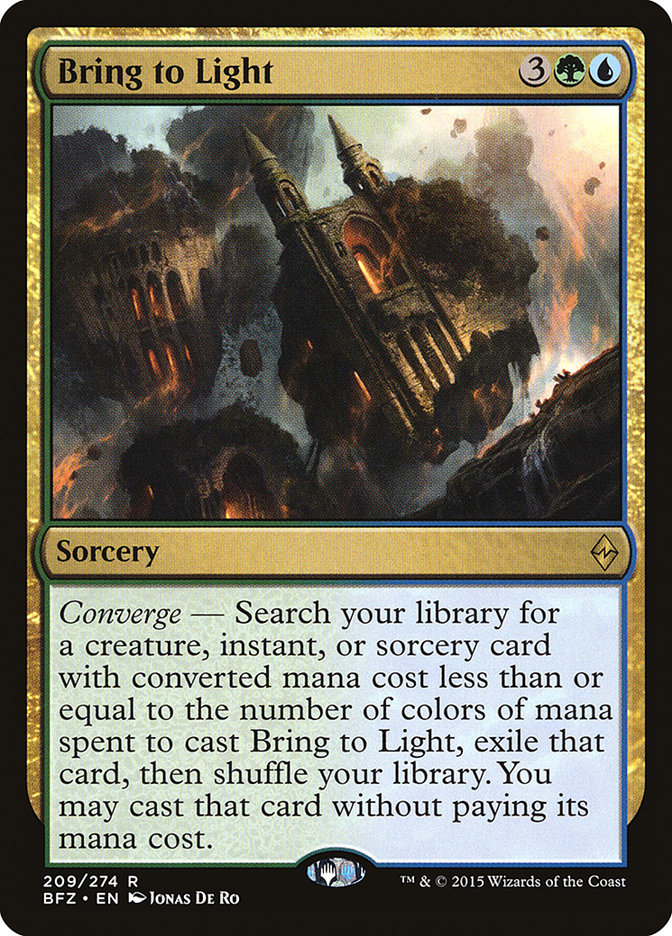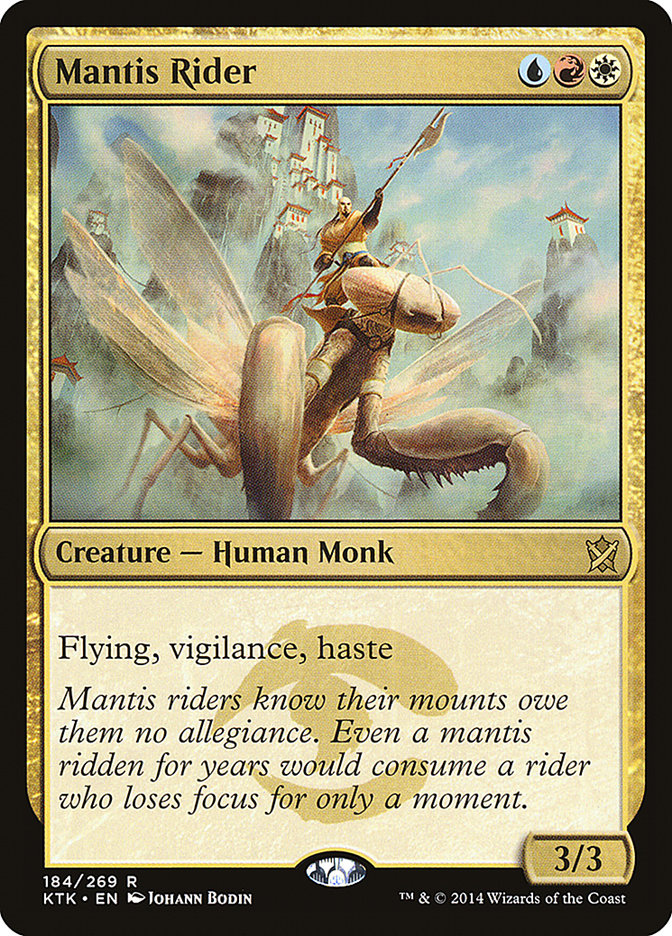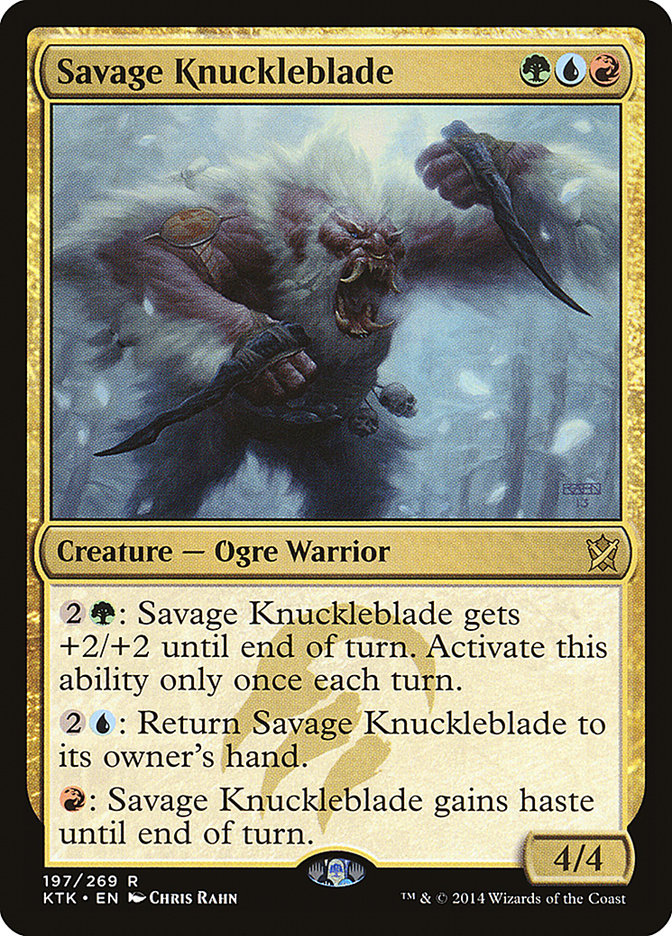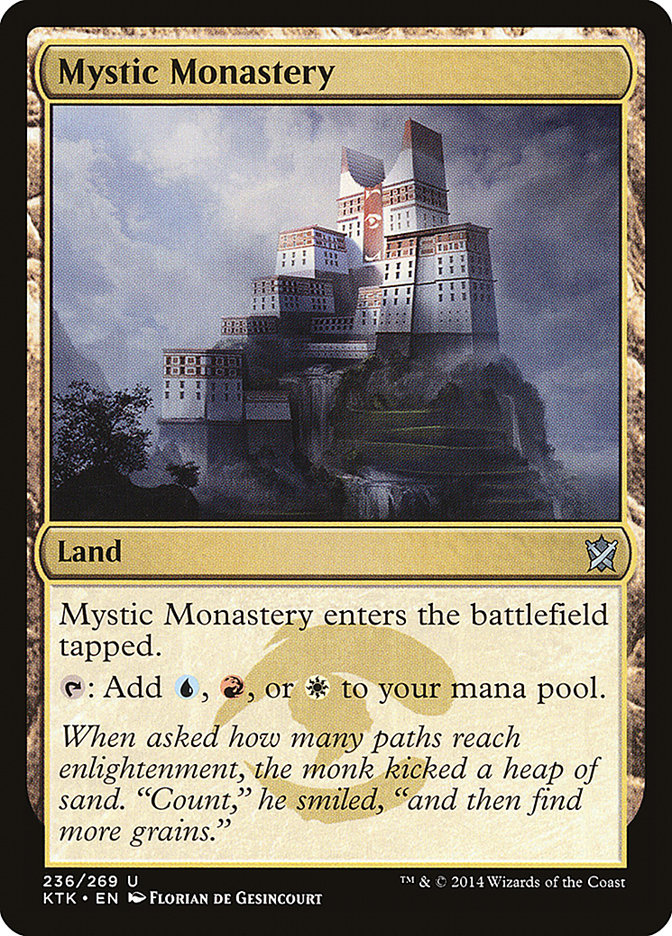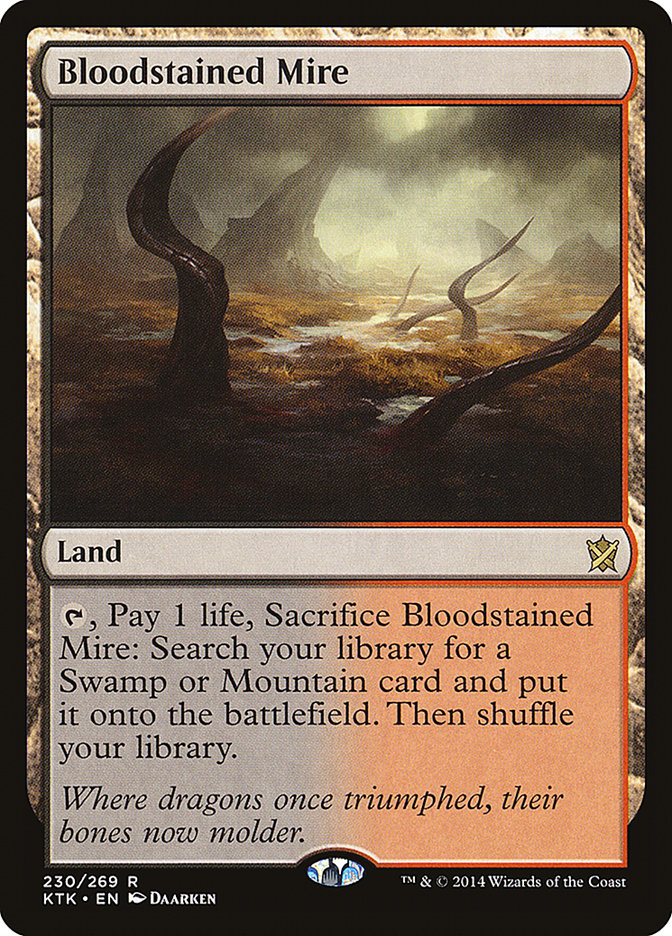As of this writing, day one of the Open Series in Indianapolis hasn’t even ended yet, but I already have my breakout card of the tournament.
A couple of weeks ago, I stated that I was worried about this card being absolutely busted in Modern, mostly because of the structure of the card and how
it can enable some ridiculously good daisy chains. This wasn’t even talking about its potential in Standard, and many of our hallmark players, including
the machine himself, Gerry Thompson, wielded the weapon to a good early start. I’d argue that his utilization of Bring to Light was the most tame out of
all of the decks featured, simply being Siege Rhinos five through eight, with the ability to grab a sweeper or spot removal spell in a pinch.
The card reminds me a lot of what Whip of Erebos did to the decks that wanted to play it last year. You began with the best balance of powerful and
synergistic cards, then slowly filled out the rest of your roster with a lean on one of those directions. Initially, many led toward straight power, with
obvious inclusions like Hornet Queen, Siege Rhino, Sidisi, Brood Tyrant, and the like. Later on, things started to become more synergistic, especially when
the format adjusted to push against Whip of Erebos strategies, and when more creatures like Den Protector, Deathmist Raptor, and Sidisi, Undead Vizier came
about. If those decks needed a bigger push in power, then Dragonlord Atarka was all they needed, which alleviated the need for multiple power cards and a lot of removal spells.
Bring to Light might behave similarly, though inversely.
In week one, we saw a heavy lean toward power, mostly because, well, it was probably the easiest direction to go. Since the format heavily promoted having
a bunch of colors, it was no surprise that Bring to Light and Siege Rhino went hand in hand. Splashing blue for the card wasn’t difficult with fetchlands,
and having red was even easier since you don’t necessarily need the red for anything else but to enable Bring to Light for five. Because of this, you can
build a traditional Abzan Midrange/Control style of deck that just has four tutors for whatever you need, which increases the midgame consistency while
also enabling a nifty toolbox for minimal effort.
The possibilities don’t end there though. Not even close. While Bring to Light might possibly have very powerful combo implications, it can probably also
be utilized in heavy control shells, where your splashes can be light while focusing on the colors you want.
But what about aggro? What can we do there?
Well, that’s what we’re here to find out.
It’s tough to evaluate, because hitting your proper colors on time is much more demanding and strenuous. Fortunately, hitting said colors seems to be much
easier than many had initially thought, so I’m leaning more toward being as aggressive on the mana as possible. It’s also important to understand that the
tri-lands don’t seem to be very good in these types of decks anymore, if they’re good at all. Fetchlands can give you all that you need, and while you’ll
lose a few percentages to red decks here and there because of the additional damage you’d be taking, this is something that can be rectified by having the
proper 75 and making up for it.
Now, since Bring to Light is base green and blue, I’m more inclined to focus on that. If we’re trying to utilize the maximum amount, then we have a ton of
options, including, but not limited to:
Savage Knuckleblade is the easiest to shoe in, as it requires the least amount of mana stretching. If we’re already going to be in red, then Mantis Rider
becomes the next inclusion, as white isn’t terribly far off from there either. Siege Rhino is just Siege Rhino and doesn’t require as much timing pressure
as the other two but is the toughest to splash if you’re already including the first two.
Another interesting question if including Bring to Light in an aggressive deck: Do you even need to have all five colors? It doesn’t sound like something
you’d be inclined to do if you’re building around this:
Chances are you don’t need five colors anyway, as your threats are likely topping out at three. This is actually in a similar vein to what Gerry did,
simply having more copies of your best card as the primary. This is something I want to focus on, as it seems to be the most interesting to build. Because
we are only focusing on four colors, black is probably the color that gets cut. Siege Rhino doesn’t work with Collected Company, and if we’re already
playing both Bring to Light and Collected Company, then we won’t have a lot of room for spells, which lessens the incentive for black regardless. With
these restrictions comes a focus, and now we can actually build the deck.
But there’s one more big piece of tension to iron out.
Creatures (28)
- 4 Rattleclaw Mystic
- 4 Mantis Rider
- 4 Savage Knuckleblade
- 4 Warden of the First Tree
- 4 Den Protector
- 4 Deathmist Raptor
- 4 Beastcaller Savant
Lands (24)
Spells (8)

Creatures (26)
- 4 Rattleclaw Mystic
- 4 Mantis Rider
- 4 Savage Knuckleblade
- 4 Warden of the First Tree
- 3 Den Protector
- 4 Deathmist Raptor
- 3 Managorger Hydra
Lands (24)
Spells (10)

The biggest question that’s asked among these two decks is the tension between Beastcaller Savant and Collected Company/Bring to Light.
There are great upsides as well as great downsides to playing this card in this particular deck. It gives you a white source for Mantis Rider, as well as a
second green source for Deathmist Raptor. The downsides? It doesn’t help you cast Bring to Light or Collected Company. It doesn’t synergize well with
Deathmist Raptor like Rattleclaw Mystic does. It adds more inconsistency and less overall power off of a Collected Company. Perhaps the lesser seen
downside, though, is the most impactful in my view: It completely changes the way you build your sideboard. The spells available are actually more
restricted to creatures, something Rattleclaw Mystic doesn’t do.
So, do you play it or not? It depends on how much you value explosiveness over consistency. It’s pretty easy to want to value consistency, especially given
Temur’s track record this past year. If you decide not to play Beastcaller Savant, is playing more non-creature spells that much better? Dromoka’s Command
is as good as it gets when it comes to getting the most out of those valuable spots. Again, the tension is now between Bring to Light and Collected Company
directly. Your Company gets more inconsistent, but it’s a bit more harsh than Beastcaller Savant in that you could just not hit at all. In exchange, Bring
to Light can now become a Dromoka’s Command if need be, and this can be worth it if you happen to be strained on colors, like lacking a white source or not
having the fourth color for Collected Company. Should you play it? Again, it depends, but let’s not forget the rest of the cast.
Warden of the First Tree leads the way at the one-drop spot. It’s one of the best ones available, and is great flood insurance, especially in a deck that
is going to be compact and not use a lot of its mana past five. If you’re looking to be aggressive, then this is where I want to start for sure. The
landfall creatures are fine, but again, I’m trying to use my mana at every point possible, as often as possible. Other considerations include Honored
Hierarch and Dragonmaster Outcast.
At two mana, Rattleclaw Mystic and Den Protector are the easy choices for me, as it’s very potent to have both a mana accelerant and some longevity in the
later game. Since your converted mana cost is restricted to three, your power options are very limited, so you’ll take whatever you can get. Other
considerations include Heir of the Wilds, Abbot of Keral Keep, Anafenza, Kin-Tree Spirit, Frost Walker, and Jace, Vryn’s Prodigy.
The three-drops are where the bulk of the power is, and Savage Knuckleblade and Mantis Rider are the best ones we have. Savage Knuckleblade is the huge
payoff, especially when jammed early. It’s very powerful at all points of the game, continues the theme that we’re looking for in wanting to use your mana
at every point possible, and is one of the few creatures that can go head to head with a Siege Rhino and live. Mantis Rider doesn’t care about Siege Rhino,
and allows a ton of incentive to cast Collected Company on your turn, which makes Bring to Light being sorcery speed not as much of a problem (part of the
reason why Beastcaller Savant is worth consideration as well). Outside of those, Deathmist Raptor being the staple of the megamorph package is the other
fairly solid inclusion. It becomes even more potent if you decide to play Dromoka’s Command, as it becomes a hard removal spell. With the absence of
Lightning Strike, and the flailing of Draconic Roar, it’s a great time to be jamming this package without much drawback, even if double green is tough to
pull off sometimes (in which case, just casting it face-down is an option). Managorger Hydra is not the most powerful out of the three drops you have
access to, but it does play very nicely with Bring to Light if it’s already on the battlefield, and can grow very quickly out of control when against decks
like blue control and Jeskai decks. I’ll be honest – I’m more inclined to play it in conjunction with Dromoka’s Command than anything, but that’s mostly
because I want to make Dromoka’s Command as powerful as possible, not because I want to make Managorger Hydra as powerful as possible. Other options
include Nissa, Vastwood Seer, Yasova Dragonclaw, and Undergrowth Champion.
The lands are the most important thing to figure out, and believe me when I say this: No one is going to get it right the first time. What we can deduce
from looking at the format first hand is that the tri-lands are just not good enough anymore.
The reasons for this aren’t clear cut at first, but if you look closer, it’ll make more sense. Essentially, the fetchlands that ally with each other in
whatever deck you decide to play can get every color you need. Plain and simple. If, for example, you’re playing a base U/W deck, and are deciding to
splash black, your Flooded Strands can get your black sources. In this deck, our eight fetches can grab whatever colors we need, but our additional fetches
are a bit more interesting. Basically, we need to ask ourselves: which is the more important color: red, or white?
Flooded Strand can grab us everything but red, and Bloodstained Mire can grab everything but white. White is important because it casts Mantis Rider and
pumps Warden of the First Tree, which Rattleclaw Mystic can’t do, and it helps with Dromoka’s Command if we decide to play it. Red is important because it
helps cast Savage Knuckleblade and gives it haste, which is extremely valuable on curve. It also helps you cast Mantis Rider, though it’s an on-color
source. For now, I think that Flooded Strand is the better option with a Dromoka’s Command configuration.
Speaking of which, why are we playing Sunken Hollow? Mostly because it’s a blue source that we can get with Bloodstained Mire. This can work with Flooded
Strand too, though not as effectively, but we do need to be able to fetch as many colors as we can. The third option is Polluted Delta, which allows us to
get a red source (Smoldering Marsh) and a white source (Prairie Stream), but not a green source, which I’m not a big fan of. The last option is Evolving
Wilds, but I’m more wary of that if we’re trying to be as aggressive as possible, even if it helps our Battle lands a little bit more. Lumbering Falls has
the same problem, but it trades the ability to help our Battle lands with some lategame attacking and/or blocking, which I don’t really care much for since
we already have Bring to Light and Collected Company.
Before we go ahead and jam this sixty, we need to figure out what the big problems are with this deck. Firstly, your mana, while still as great as what was
displayed this past weekend, is going to be more sketchy because of how demanding you need to hit the colors you need on time. What made a lot of
the Abzan decks work so well was their lack of needing to hit everything on time, so we need to put an extra focus on making the lands work before
anything. Secondly, Mono-Red is going to eat us alive in game 1, as Dromoka’s Command is the only real big defense we have. Sure, we can cast a Savage
Knuckleblade on defense, as well as ride the Mantis Rider wave, but we cannot afford to stumble at all. In fact, against any deck that is going to pressure
us early and often, we can’t afford to stumble. We have to lean pretty heavily on our sideboard to pull things together. Lastly, the tension between all
that’s going on in the deck is going to cost you throughout the course of a tournament if you aren’t taking extra care of how you build the deck. There
will be times where you draw no creatures and all Collected Companies/Bring to Lights against Mono-Red, Savage Knuckleblade against Deathmist Raptor decks,
etc.
Is Jace worth it?
Jace is an interesting card in the context of this deck. At the core, you want to be attacking. Easy. If we look further, however, Jace is actually a fine
card to use when you’re pressing the offense as well. Recasting Collected Company and Bring to Light is pretty strong, especially when it doesn’t cost you
a card. Drawing more cards in general is always good, and hitting additional Dromoka’s Commands is reason enough for me to want to play some number of it.
Again, tension rears its ugly head, and the pieces that make you want to cast Collected Company on your turn don’t particularly like the pieces that make
you want to play Jace. Is that reason enough to not play it? It might be, but the other available two-drops aren’t really doing it for me, so I don’t mind
being in on it.
With all of this said, this is what looks to be the closest thing to what I want to be doing:
Creatures (26)
- 4 Rattleclaw Mystic
- 4 Mantis Rider
- 4 Savage Knuckleblade
- 4 Warden of the First Tree
- 4 Den Protector
- 4 Deathmist Raptor
- 2 Jace, Vryn's Prodigy
Lands (24)
Spells (10)

Of course, works in progress are just that, but this is one of the many things you can do with Bring to Light. Is it the best Bring to Light deck
available? Likely not, but you don’t have to be the best single card deck to be a good deck. It would not surprise me if we see more of this card in the
near future, as it is looking more and more like this is the real deal for real deckbuilders.

